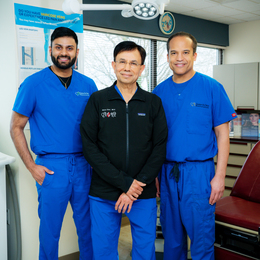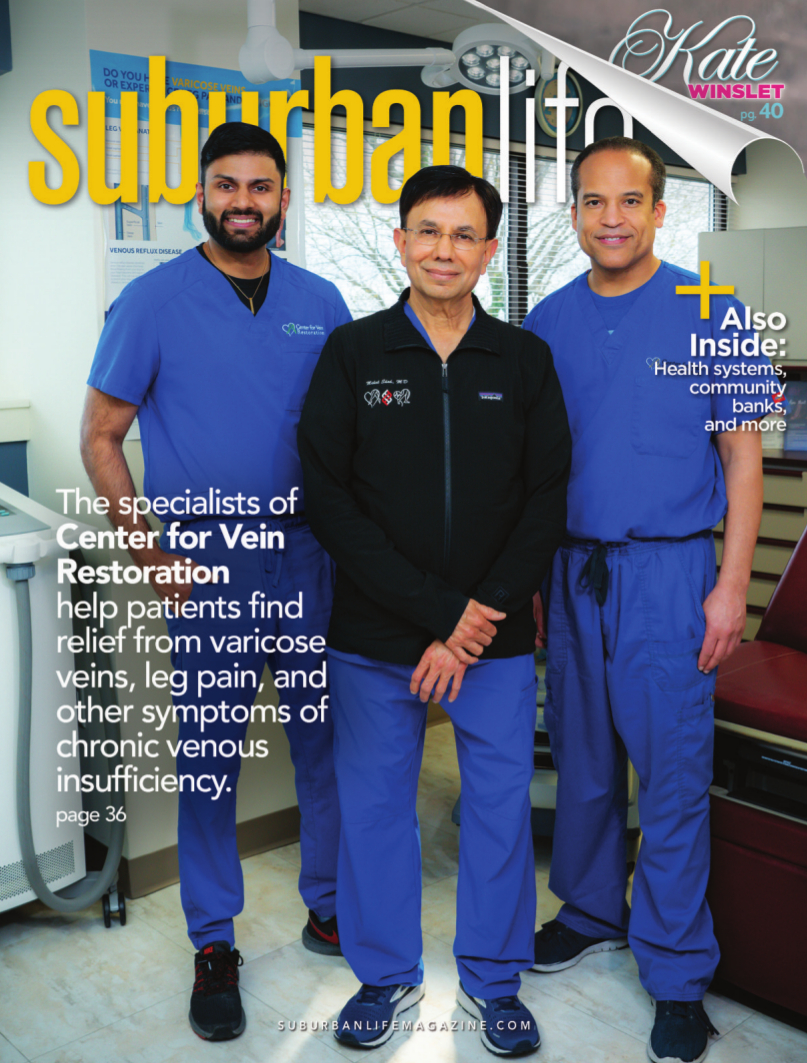
Back in Step
The specialists of Center for Vein Restoration help patients find relief from varicose veins, leg pain, and other symptoms of chronic venous insufficiency.
During his internal medicine residency at Northeast Ohio Medical University, Abhi Kasinadhuni, M.D., encountered a patient who changed the trajectory of his career.
“He came in with terrible legs—inflamed, discolored, venous ulcers—and I wound up sending him to a vascular surgeon,” says Dr. Kasinadhuni, who goes by “Dr. Kas.” “He was so deeply affected by venous disease to the point that he was completely dependent on other people. Within months, because of the treatment he received, his entire situation changed. I knew from then on that I wanted the satisfaction that comes from knowing I could make patients better.”
Dr. Kas went on to earn a prestigious 12-month Center for Vein Restoration (CVR) Fellowship in Venous and Lymphatic Medicine. After completing the fellowship, he joined CVR, which is the country’s largest vein-care provider. He now splits his time between CVR’s offices in King of Prussia and Wayne, Pennsylvania, as a successor to Tony Carabasi III, M.D., FACS, a pioneering vascular surgeon who recently retired.
“For that first gentleman I helped turn around, we were able to give him his life and his legs back,” Dr. Kas adds. “Now I get to help offer similar results for other patients every day.”
‘Very Treatable’
More than 25 million Americans suffer from chronic venous insufficiency (CVI). Risk factors for the disease include genetics, occupational risk factors, pregnancy, and obesity. CVI is commonly the underlying cause of unsightly varicose veins found on the legs. While many patients do not present with visible surface veins, they do experience other symptoms that can affect their quality of life, such as tired, heavy, or restless legs, as well as frequent leg cramps.
Despite its prevalence, less than 2 million people seek treatment; of those who do, only 500,000 individuals receive effective treatment due to incorrect diagnoses. If left untreated, the condition can worsen and put a patient at a higher risk of conditions such as deep-vein thrombosis and venous ulcers around the lower legs and ankles, according to Mehul N. Shah, M.D. Dr. Shah is a board-certified vascular physician and phlebologist who works at CVR’s King of Prussia location.
“The good news is that CVI is very treatable, and we’re able to use modern minimally invasive modalities that can be performed right in our office,” says Dr. Shah, who has more than 30 years of experience in vascular surgery. “Most people are surprised to learn that they can walk in and out of our office [after treatment] and be back to work the next day.”
These office-based procedures include endovenous thermal ablation using radio-frequency or laser, Venaseal (medical-grade cyanoacrylate glue), and Clarivein (mechanic-occlusive chemical ablation), all of which are delivered by way of a catheter. Varithena, an ultrasound-guided microfoam, is injected directly into the vein. Varicose veins may also be treated with a minimally invasive surgery known as a micro-phlebectomy. Dr. Shah points out that these procedures are usually covered by insurance when medically indicated in symptomatic patients.
Delivering Results
CVR focuses exclusively on treating vein disease. The company has more than 100 offices in 20 states and Washington, D.C., plus a presence on Capitol Hill to advocate for those who suffer from the disease. CVR’s resources and leadership are what compelled Michael J. Cornwell, M.D., to join the company approximately three years ago.
“CVR has a lot of very good doctors, not just in this area but across the country,” says Dr. Cornwell, a general surgeon and phlebologist who splits his time between CVR’s offices in Bensalem and Horsham, Pennsylvania. “That’s a nice aspect of what we do because patients always have a resource they can trust even if they move from one state to another. There’s a drive among all CVR doctors to always get better, to continue learning, and to improve the overall care we deliver to patients over time. Those two words—over time—are important because this is a chronic condition that requires long-term surveillance.”
Dr. Kas agrees. In fact, when he recalls his decision to specialize in the treatment of CVI, he traces the decision back to two primary factors: the lasting relationships he gets to form with patients, and the life-changing results he can deliver.
“I have a passion for helping the people who are affected by vein disease, and I think you can say the same about every physician at CVR,” says Dr. Kas. “What we’re able to do for patients goes far beyond fixing their legs. That’s the most gratifying part about what we do—seeing the kind of positive impact you can have on someone’s life for months and years to come.”
The Truth About CVI
CVR debunks ten common myths about chronic venous insufficiency and varicose veins.
Chronic venous insufficiency (CVI) is twice as common as coronary artery disease and five times more common than peripheral artery disease, according to Dr. Mehul N. Shah of CVR’s office in King of Prussia. Despite the prevalence of varicose veins and other symptoms of CVI, the following myths suggest most people do not have a good understanding of the disease.
Myth No. 1: “Varicose veins will come back after treatment.” The truth: Modern treatment modalities using minimally invasive methods can successfully treat varicose veins, and treated veins are unlikely to return. New veins may appear due to disease progression.
Myth No. 2: “Varicose veins treatment is painful and requires ample recovery time.” The truth: Modern methods are mostly non-surgical, minimally invasive, and performed under local anesthetic. As a result, patients return to work and other activities as soon as the following day.
Myth No. 3: “Venous insufficiency is always visible.” The truth: Surface varicose veins—the bulging veins that can be seen with the naked eye—may only be the tip of the iceberg. Patients with venous insufficiency may develop varicose veins.
Myth No. 4: “Varicose vein treatment is not covered by insurance.” The truth: When varicose veins are symptomatic, they are mostly covered by insurance if the patient meets certain criteria.
Myth No. 5: “Varicose vein treatment is purely cosmetic.” The truth: When medically indicated due to symptoms, the treatment is medical and not cosmetic.
Myth No. 6: “Varicose veins are benign and, hence, should be left alone.” The truth: CVI can lead to leg swelling and skin thickening with skin discoloration and may also lead to venous ulcers. Patients are also at higher risk for superficial thrombophlebitis and deep-vein thrombosis. If treated early, complications can be avoided, and progression can be halted.
Myth No. 7: “Women should wait to seek treatment until after child-bearing age.” The truth: If CVI and varicose veins are treated before pregnancy, a woman does not have to suffer as much pain and swelling in the legs during pregnancy. New veins that occur due to pregnancy can be treated later.
Myth No. 8: “Venous ulcers need only wound care.” The truth: When localized treatment of chronic venous ulcers has not healed the wound, treatment of the underlying venous reflux will result in healing of the venous ulcer within a few weeks.
Myth No. 9: “Men do not get varicose veins.” The truth: While varicose veins are four times more common in women than men, men do suffer from CVI.
Myth No. 10: “Redness with thickening of the skin suggests cellulitis.” The truth: Patients with CVI often have superficial thrombophlebitis, which is best treated with NSAIDs and warm compresses. Primary care physicians and doctors in the ER or urgent-care setting often prescribe antibiotics unnecessarily.
For more information on Center for Vein Restoration, including details on nearby locations in Bensalem, Horsham, King of Prussia, and Wayne, visit centerforvein.com or call 1-800-FIX-LEGS.
Photograph by Jody Robinson
Published (and copyrighted) in Suburban Life, May 2021.



